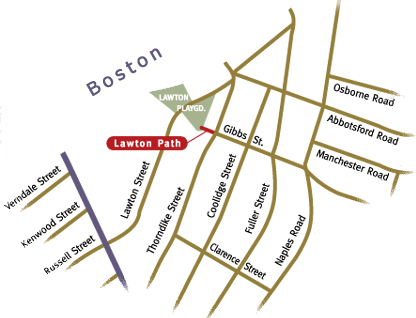Lawton Path is less a path and more a passageway; it is, after all, only 69 feet long. Its modest length in no way diminishes its utility, however. Beginning on Thorndike Street directly opposite the end of Gibbs Street, the path's entrance is flanked by two strategically placed benches. There are no signposts marking the path, but standing at the entrance, you can see into the park, which is welcoming and inviting.
Lawton Playground
Passing between two brick residential buildings, the path is bordered by tall bushes on the left, their density providing a substantial visual barrier. Once beyond the adjacent buildings, the path enters Lawton playground and continues through to Lawton Street. Shaded picnic tables on your left encourage further exploration. Despite its small size, the playground and park contain a great variety of design elements, which divide the limited acreage into a number of distinct areas. Nevertheless, there is an easy flow and openness to the park. Pine trees cover a hilly section to the south, creating a landscape that evokes a woodsy lakeside. Towering sycamore trees shade the pathway, their patterned bark creating a colorful and textured visual treat, even in the barren winter months. To your right, towards the north, there are the patterned, formal stone structures: a fountain spray pool and a curving stone wall that doubles as seating for mothers watching their young children. The play area itself is colorful and stimulating for youngsters on the go.
Upon reaching Lawton Street, the fenced in shelter of the park gives way to a streetscape of two story brick office buildings. Directly across the street, the spacious basketball courts beckon, also part of Lawton playground. Further down the street to the right, busy traffic on Commonwealth Avenue accentuates the contrast between park and street.
Henry Coolidge's Farm
Lawton playground is a much-needed park and play space serving the neighborhoods of north Brookline. Here, streets are lined with closely spaced single-family homes built without provision for significant public open space. Improved transportation amenities and population growth transformed the area's farms and suburban estates into a family friendly neighborhood for Boston professionals. Building boomed in north Brookline around the turn of the last century, and as with much of Brookline, it was the widening of Beacon Street in 1886 that triggered rapid change. The widening brought a trolley line that ran on Beacon Street to Coolidge Corner, then turned onto Harvard Street to continue north to Allston. Initially, the resulting development was focused on these two streets. The growth brought developers such as Henry Coolidge, who had inherited his family's farm. Hiring architects, he built homes on streets radiating off of Harvard Street, such as Columbia. To the east of Lawton park, in the Naples Road area (which encompasses the recently designated Graffam-McKay Local Historic District), development was instead focused on Commonwealth Avenue. Here, the neighborhoods' prosperous Boston professionals commuted by carriage, since trolley service did not reach Commonwealth Avenue until 1909.
Unique in its newness, Lawton Path was created in 1972 to provide access to the Lawton playground. The path's recent creation is encouraging. It illustrates the relevance of dedicated public footpaths in modern times, and reminds us that careful consideration for pedestrian access can greatly enhance the everyday experience of neighborhood life.